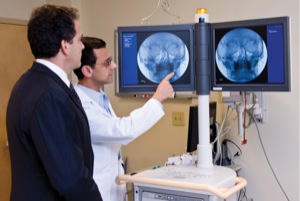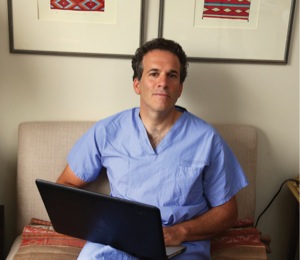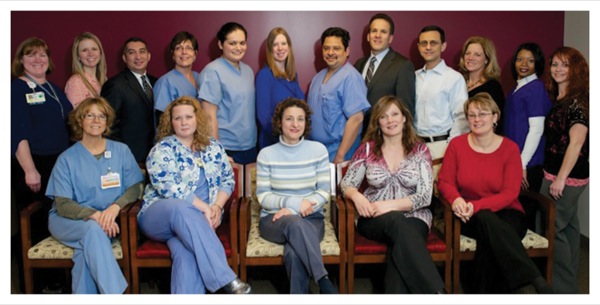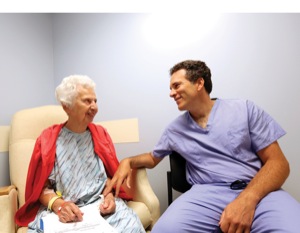New York State Pain Center Views Chronic Pain Through a Distinctive Lens
Two
lumbar laminectomies left retired college professor Lewis Neisner with
nerve damage and severe pain in his left leg. After seeing a number of
physicians who were unable to help him, Mr. Neisner took the advice of
friends and made an appointment at the Neuromedicine Pain Management
Center (NPMC) at the University of Rochester Medical Center, in
Rochester, N.Y.
“I was hoping the center could relieve my pain or at least make it more manageable,” he said.
At NPMC, Mr. Neisner was surprised that he did not have to undergo the same battery of tests administered by other physicians—including yet another magnetic resonance imaging (MRI) scan—but instead got a complete neurologic exam.
Investigating the neurosensory aspects and functional consequences of
chronic pain defines NPMC’s pain management approach. “We have a
distinctive lens,” said John Markman, MD, NPMC’s director. “The preface
to an Institute of Medicine report in 2011 stated, ‘chronic pain arises
from the nervous system.’ We focus on pain as it relates to nerve injury
in the setting of a neurobehavioral syndrome.”
NPMC has been delivering coordinated pain management since 2008, tailoring treatment plans that stress diverse approaches and continuity of care. It is uniquely situated within the University of Rochester Medical Center’s Department of Neurosurgery, where it collaborates with surgical colleagues in managing the long-term, often painful consequences of craniotomy, laminectomy, brachial plexus avulsion and tumor resections. It also performs novel functional risk assessment up-front and postintervention for elective surgeries, such as lumbar stenosis decompression. In 2013, the American Pain Society honored NPMC with its Clinical Center of Excellence Award for outcomes, multidisciplinary care and research. It was the only academic medical center to earn the award in 2013.
No Single Remedy
NPMC operates under the belief that chronic pain is both a symptom and an underlying neurologic disorder. Its care is grounded in the notion that the most complex nerve injury, whether painful peripheral neuropathy or postherpetic neuralgia, results in a chronic problem that cannot be resolved with a single pill, injection or surgery.
“In most patients, different levels of the nervous system are involved, so our challenge is to figure out what parts are contributing to a patient’s pain experience at a given moment,” Dr. Markman said. “We focus on understanding that experience—that is, all of the quality-of-life aspects regarding a patient’s pain. We want to help patients understand this experience and not have pain as the axis around which their lives revolve.”
To treat the “experience of pain” effectively, NPMC harnesses the strengths of multiple, innovative therapies—medical management, as well as rehabilitative, psychological, integrative and complex procedural interventions. This approach emphasizes improved coping and self-efficacy. Clinician–patient conversations, medications, diagnostic queries and interventions seek to minimize fear-avoidant behaviors and de-emphasize pain intensity in favor of functional improvement.
To this end, NPMC has created programs of excellence for specific pain conditions, such as its trigeminal neuralgia (TN) program, which incorporates quantitative sensory testing and evaluation of conditioned pain modulation into treatment decisions. TN can cause intense stabbing or electrical shock–like facial pain, originating from the trigeminal nerve. When patients with TN come to NPMC, a neurologist examines them; a neuroradiologist interprets imaging findings; a dentist excludes oral pathology; and a neurosurgeon explores the gamut and timing of procedural treatment options.
“Our team of medical and surgical experts work together to fully assess a TN patient’s pain and provide all options—medical, surgical or a combination—in a comprehensive treatment paradigm,” Dr. Markman said.
NPMC’s TN program is the only one of its kind in upstate New York.
State-of-the-Art Center
NPMC is a 10,000-square-foot facility linked to the University of Rochester Medical Center, where world-class diagnostic technologies, such as computer-assisted imaging guidance, functional MRI and awake brain mapping are standards of care. It is conveniently located near the medical center’s main facility, Strong Memorial Hospital, and other resources such as the university’s Investigational Drug Service Pharmacy.
The center’s team is multidisciplinary, with neurologists, neurosurgeons, pain medicine specialists, radiologists, anesthesiologists, psychologists, physical therapists, and nurse practitioners and technicians of all types working in concert to help pain patients overcome their pain and get their lives back.
“Our team collaborates on all levels to provide quality care,” said Shirley Rast, NP, one of NPMC’s advance dpractice providers. “We review imaging, treatment and responses to surgery and medications to plan together the next step in a patient’s care. We confer with referring providers, psychologists, psychiatrists, counselors and physical therapists to optimize care.”
The advanced practice providers’ function at NPMC adds a depth to the collaborative nature of its team not often seen at other pain centers. “We are nationally certified and state licensed,” Ms. Rast explained. “Our role involves evaluating and diagnosing new patients, including imaging and diagnostic testing; setting up treatment plans and interventions; and medical management, such as recommending and/or prescribing controlled and noncontrolled medications. We follow up with patients to evaluate their responses to treatment—interventional, surgical, pharmacologic and nonpharmacologic. Our practice incorporates individual counseling as an integral component of pain management. In the end, we try to get patients to understand their pain, motivations and drivers to customize their care.”
“We also are committed to treating patients over the lifetime of the problem,” Dr. Markman added. “We just don’t treat symptoms. This is especially important with chronic conditions, which often are long term.”
More than 8,000 patients from western New York state, the Finger
Lakes region, as well as Pennsylvania and Canada, seek NPMC’s help each
year. Recently, the center has made efforts to reach more patients in
underserved rural areas by opening an outreach clinic in Auburn, N.Y.,
some 70 miles away, and it hopes to establish additional satellite
locations over the next year.
Discovering Tomorrow’s Treatments
NPMC is actively involved in research and clinical trials in an effort to discover new chronic pain treatments. Research is conducted at its Translational Pain Research Unit, a separate 3,000-square-foot research facility that includes five patient examination rooms; a procedure suite, with fluoroscopic guidance for cerebrospinal fluid sampling and conscious sedation capabilities; four recovery rooms; and a dedicated trial monitor room, with high-speed broadband for remote data entry.
The principal focus of the research program has long been low back pain, the most common chronic pain syndrome. Recent clinical studies include a placebo-controlled, randomized, double-blind crossover clinical trial on postlaminectomy pain and randomized controlled trials on the most common treatments for lumbar stenosis. The center also initiates and participates in clinical trials on urine drug testing methods, protein therapies and devices such as spinal cord stimulators.
Dr. Markman and Babak S. Jahromi, MD, PhD, surgical director of the Stroke and Cerebrovascular Center, are leading a team that is investigating new treatments for neuropathic craniofacial pain involving the nucleus caudalis.
Since its founding, NPMC has made outcome assessment a critical component of care. It has conducted the Neurosurgical Outcomes Project to collect and store health care information on the large number of patients it has treated for lumbar spinal stenosis and other index conditions.
More recently, the center has used the Patient Global Impression of Change index, which rates the response of a condition to therapy with pain scores and other required electronic medical record components, capturing this feedback with every patient encounter.
Educating pain specialists, medical students and the public about chronic pain is another key role that NPMC plays in advocacy efforts for patients with chronic pain. Its continuing medical education (CME) program, Advances in Pain Management and monthly Translational Pain Research Forum CME series, launched in 2009, bring together basic and clinical scientists with pain practitioners of all types throughout the region.
“We also offer educational activities geared toward clinicians of varied backgrounds including physicians, physician assistants, nurse practitioners, pharmacists, therapists and nurses, as well as all other allied health care professionals, who on a daily basis confront the challenge of treating acute and chronic pain conditions,” said Dr. Markman.
As for Mr. Neisner, selecting NPMC proved the right decision. His treatment plan included a switch from oral hydrocodone to a buprenorphine transdermal patch for more convenient and durable pain relief. He also participated in a clinical trial investigating a new medication for neuropathic pain in people who have had lumbar surgery.
“It has been a very positive experience,” he said. “The center has helped me manage my pain more effectively. It has educated me about my pain, and that has given me peace of mind. And I have confidence that if I need something more, it can provide it.”
—Tom McDonough
“I was hoping the center could relieve my pain or at least make it more manageable,” he said.
At NPMC, Mr. Neisner was surprised that he did not have to undergo the same battery of tests administered by other physicians—including yet another magnetic resonance imaging (MRI) scan—but instead got a complete neurologic exam.
NPMC has been delivering coordinated pain management since 2008, tailoring treatment plans that stress diverse approaches and continuity of care. It is uniquely situated within the University of Rochester Medical Center’s Department of Neurosurgery, where it collaborates with surgical colleagues in managing the long-term, often painful consequences of craniotomy, laminectomy, brachial plexus avulsion and tumor resections. It also performs novel functional risk assessment up-front and postintervention for elective surgeries, such as lumbar stenosis decompression. In 2013, the American Pain Society honored NPMC with its Clinical Center of Excellence Award for outcomes, multidisciplinary care and research. It was the only academic medical center to earn the award in 2013.
No Single Remedy
NPMC operates under the belief that chronic pain is both a symptom and an underlying neurologic disorder. Its care is grounded in the notion that the most complex nerve injury, whether painful peripheral neuropathy or postherpetic neuralgia, results in a chronic problem that cannot be resolved with a single pill, injection or surgery.
“In most patients, different levels of the nervous system are involved, so our challenge is to figure out what parts are contributing to a patient’s pain experience at a given moment,” Dr. Markman said. “We focus on understanding that experience—that is, all of the quality-of-life aspects regarding a patient’s pain. We want to help patients understand this experience and not have pain as the axis around which their lives revolve.”
To treat the “experience of pain” effectively, NPMC harnesses the strengths of multiple, innovative therapies—medical management, as well as rehabilitative, psychological, integrative and complex procedural interventions. This approach emphasizes improved coping and self-efficacy. Clinician–patient conversations, medications, diagnostic queries and interventions seek to minimize fear-avoidant behaviors and de-emphasize pain intensity in favor of functional improvement.
To this end, NPMC has created programs of excellence for specific pain conditions, such as its trigeminal neuralgia (TN) program, which incorporates quantitative sensory testing and evaluation of conditioned pain modulation into treatment decisions. TN can cause intense stabbing or electrical shock–like facial pain, originating from the trigeminal nerve. When patients with TN come to NPMC, a neurologist examines them; a neuroradiologist interprets imaging findings; a dentist excludes oral pathology; and a neurosurgeon explores the gamut and timing of procedural treatment options.
“Our team of medical and surgical experts work together to fully assess a TN patient’s pain and provide all options—medical, surgical or a combination—in a comprehensive treatment paradigm,” Dr. Markman said.
NPMC’s TN program is the only one of its kind in upstate New York.
NPMC is a 10,000-square-foot facility linked to the University of Rochester Medical Center, where world-class diagnostic technologies, such as computer-assisted imaging guidance, functional MRI and awake brain mapping are standards of care. It is conveniently located near the medical center’s main facility, Strong Memorial Hospital, and other resources such as the university’s Investigational Drug Service Pharmacy.
The center’s team is multidisciplinary, with neurologists, neurosurgeons, pain medicine specialists, radiologists, anesthesiologists, psychologists, physical therapists, and nurse practitioners and technicians of all types working in concert to help pain patients overcome their pain and get their lives back.
“Our team collaborates on all levels to provide quality care,” said Shirley Rast, NP, one of NPMC’s advance dpractice providers. “We review imaging, treatment and responses to surgery and medications to plan together the next step in a patient’s care. We confer with referring providers, psychologists, psychiatrists, counselors and physical therapists to optimize care.”
The advanced practice providers’ function at NPMC adds a depth to the collaborative nature of its team not often seen at other pain centers. “We are nationally certified and state licensed,” Ms. Rast explained. “Our role involves evaluating and diagnosing new patients, including imaging and diagnostic testing; setting up treatment plans and interventions; and medical management, such as recommending and/or prescribing controlled and noncontrolled medications. We follow up with patients to evaluate their responses to treatment—interventional, surgical, pharmacologic and nonpharmacologic. Our practice incorporates individual counseling as an integral component of pain management. In the end, we try to get patients to understand their pain, motivations and drivers to customize their care.”
“We also are committed to treating patients over the lifetime of the problem,” Dr. Markman added. “We just don’t treat symptoms. This is especially important with chronic conditions, which often are long term.”
Discovering Tomorrow’s Treatments
NPMC is actively involved in research and clinical trials in an effort to discover new chronic pain treatments. Research is conducted at its Translational Pain Research Unit, a separate 3,000-square-foot research facility that includes five patient examination rooms; a procedure suite, with fluoroscopic guidance for cerebrospinal fluid sampling and conscious sedation capabilities; four recovery rooms; and a dedicated trial monitor room, with high-speed broadband for remote data entry.
The principal focus of the research program has long been low back pain, the most common chronic pain syndrome. Recent clinical studies include a placebo-controlled, randomized, double-blind crossover clinical trial on postlaminectomy pain and randomized controlled trials on the most common treatments for lumbar stenosis. The center also initiates and participates in clinical trials on urine drug testing methods, protein therapies and devices such as spinal cord stimulators.
Dr. Markman and Babak S. Jahromi, MD, PhD, surgical director of the Stroke and Cerebrovascular Center, are leading a team that is investigating new treatments for neuropathic craniofacial pain involving the nucleus caudalis.
Since its founding, NPMC has made outcome assessment a critical component of care. It has conducted the Neurosurgical Outcomes Project to collect and store health care information on the large number of patients it has treated for lumbar spinal stenosis and other index conditions.
More recently, the center has used the Patient Global Impression of Change index, which rates the response of a condition to therapy with pain scores and other required electronic medical record components, capturing this feedback with every patient encounter.
Educating pain specialists, medical students and the public about chronic pain is another key role that NPMC plays in advocacy efforts for patients with chronic pain. Its continuing medical education (CME) program, Advances in Pain Management and monthly Translational Pain Research Forum CME series, launched in 2009, bring together basic and clinical scientists with pain practitioners of all types throughout the region.
“We also offer educational activities geared toward clinicians of varied backgrounds including physicians, physician assistants, nurse practitioners, pharmacists, therapists and nurses, as well as all other allied health care professionals, who on a daily basis confront the challenge of treating acute and chronic pain conditions,” said Dr. Markman.
As for Mr. Neisner, selecting NPMC proved the right decision. His treatment plan included a switch from oral hydrocodone to a buprenorphine transdermal patch for more convenient and durable pain relief. He also participated in a clinical trial investigating a new medication for neuropathic pain in people who have had lumbar surgery.
“It has been a very positive experience,” he said. “The center has helped me manage my pain more effectively. It has educated me about my pain, and that has given me peace of mind. And I have confidence that if I need something more, it can provide it.”
—Tom McDonough




No comments:
Post a Comment